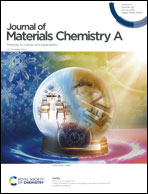A time and resource efficient machine learning assisted design of non-fullerene small molecule acceptors for P3HT-based organic solar cells and green solvent selection†
Abstract
The power conversion efficiency (PCE) of organic solar cells (OSCs) is increasing continuously, however, commercialization is far from being achieved due to the very high synthetic cost of materials and toxic solvents. Poly(3-hexylthiophene) (P3HT) is the cheapest donor, however, its PCE has remained relatively low for a long time. Recently, a PCE of over 9% has been reported. This study was performed with the aim of predicting the performance of P3HT based organic solar cells through statistical data fit, bypassing the complexity of OSC devices. For this purpose, we have used machine learning to explore data from previously reported devices. Molecular descriptors were used to train machine learning models. We have identified the descriptors that have a positive impact on the PCE. Various machine learning models are used to classify non-fullerene acceptors (NFAs) on the basis of their PCEs. We have also developed various regression models to predict the PCE. The support vector machine showed the best predictive capability. Machine learning models were also trained to predict the energy levels. Over 3000 NFAs were designed using high performing and easily synthesizable building blocks. For virtual screening of new molecules, energy levels were predicted through the already trained model. Acceptors with suitable energy levels matching with those of P3HT were selected. The PCEs of these selected acceptors were also predicted. 87 acceptors with >7.5% PCE were selected. Green solvents were selected on the basis of Hansen solubility parameters predicted using machine learning. Green solvent-containing organic solar cells have better scope of commercialization due to their environment-friendly nature. This study will pave the way for the cheap and fast design of materials for efficient P3HT-based organic solar cells. This study will help to select potential candidates and speed up the breakthroughs.



 Please wait while we load your content...
Please wait while we load your content...